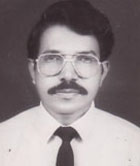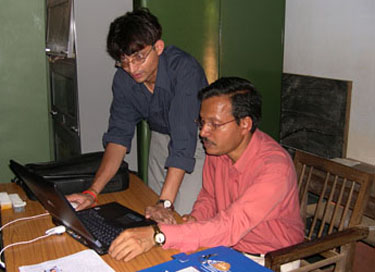 |
|
 |
||
|
|
||||
|
Designed , developed & Hosted By Kishoo, Barkur |
||||
|
|
||||
|
For your comments and contributions mail to |
||||
|
We are pleased to publish an Interview exclusively for the vistors of barkur.com, with Dr. B. Jagadeesh Shetty, Professor and Head of the Department of History, Poornaprajna College, Udupi-576101. Our team members Kishoo, Harry D’Souza and Mr.Stephen Lewis of Mayura Studio & Video, Saligrama, met Dr. Shetty at his residence. Here is the interview…
Dr. Jagadeesh Shetty and Dr. Vasanth Shetty
Mr. Stephen Lewis with Dr.Shetty Q: Good morning, Professor Shetty, namaskara. Thank you very much for finding some time to talk to us. Being a History Professor, you are the right person to enlighten us by disclosing the history and the historical importance of Barkur. Hence, please share your hard earned, thoroughly researched, authentic and expert knowledge of the history of Barkur for the benefit of Barkur.com readers. A: Thank you and thanks to Barkur.com for giving me this opportunity. ‘Barkur’ is more of a modern, and a shortened name.However, let me use Barakuru as most of us address it thus locally. I feel more comfortable to use Barakuru than Barkur! Q: Yes sir, sorry to interrupt, The Barkur region is known for shortening the words like ‘Nanage Hoga beku’ to ‘Hoik’ and ‘burk’ for ‘Bara Beku’; thus Baraakkanaooru became Barakuru, and then Barkur, I believe. Besides, just as the name shortened the glory and wealth of Barkur got smaller too. Sorry, please continue! A: Barakuru is a very ancient place. Human settlement in Barakuru did start from pre-historic times. Dr. K. B. Shivatarak has discovered some Microlithic (small stone) remains in Barakuru. Late Dr. B. Vasanth Shetty brought to light some Neolithic (Later part of the stone age, during which man developed polished stone tools and weapons and raised domesticated cattle, etc.) remains in the surroundings of Barakuru, Dr. P. Gururaja Bhat, A. Sundara, B. Vasantha Shetty and myself have been able to discover some evidences of Megalithic (consisting of huge stones applied to ancient structures and monuments…) In the historic period, Barakuru gained administrative importance, when it became the capital city under the Alupas in the 12th century A.D. It was also the main stream of political activity under the Hoysalas of Dwarasamudra. It was a provincial capital during the Vijayanagara rule. It continued to enjoy much political importance under the Keladi rulers. Subsequently it came under the control of Haider and Tippu. With the defeat of Tippu taking place in 1799 it became a part of the British Empire. (Remote areas were neglected then.) After independence like many other historical places it became a non-descript village. It’s up to us to bring back the lost glory. A few details may help in deciding the antiquity of Barakuru and its political and cultural importance. There are number of Alupa records in Barakuru which speak about their activities in this capital city. They had set up a mint here and issued gold coins. They took much interest in the development of the capital into an urban centre. The Hoysalas were the first imperial power of Karnataka to establish their direct rule in Barakuru. Chikkayi-Thayi an Alupa princess who was given in marriage to Ballal III remained in Barakuru and exercised Hoysala authority on behalf of Ballala III. She remained here up to 1348 A.D. However it is interesting to note that the Alupas who were also continuing their rule during this time and the Vijayanagar rulers who had established their authority over Tulunadu, maintained very cordial relations with each other. However there is no such mention about each other in their respective records. Vijayanagara hegemony was established here right from the birth of the empire. Barakuru rajya was ruled by a Governor under Vijayanagara and Keladi rulers. More than 80 Governors served here. The Governor administered with the help of "Kattaleyavaru". They assisted the Governor not only in civil administration but also in war efforts. In the post Keladi period Barakuru lost its importance. During the British rule it was a Taluka headquarter, with a Munsif Court. In the course of time offices were relocated in Brahmavar, though the name of the Taluk unchanged. In the pre-British period Barakuru was divided into 10 keris for administrative convenience. Each Keri had its own customs and regulations and its own presiding deity. The chief God of all the 10 keris was Narayana. From the early centuries of Christian era Barkuru had trade contacts with the western world and upghat regions of Karnataka. It was one of the chief cities of coastal Karnataka. During Vijayanagara Barakuru had trade contacts with Ormuz, Aden, Cannanore and Calicut. The Portuguese had a "factory" in Barakuru. Shaivism, Vaishnavism and Jainism were the important religions in Barakuru. Temples belonging to these religions were built here. Markandesvara or Panchalingesvara of Kotekeri, Somesvara Temple at Moodukeri, Chaulikeri Kellangere Ganesha Temple and Somanathesvara Temple at manigarakeri were the important centres of Nathapantha. Shakti cult worship was also popular. Islam seems to have come to Barakuru in the early medieval period. It was in the later medieval period that Christianity spread to Barakuru.
Kishoo with Dr.Shetty at National First Grade College, Barkur Q: Such a rich past, and the lost glory. Can we bring more worshippers to help restore these 10 keris? Or perhaps, how Barkur can be developed into tourist spot? A: If Archaeology dept. and District administration takes interest, Barakuru can certainly be developed as one of the tourist centres. The first thing that they may do here is to build a few resorts in the backwaters of river Sita with house boats and water sports facilities. (The fragile river edges have to be reinforced with stone walls, if not the waves caused by these motor driven boats will wash away the edges, which will make the landowners furious.) They should also develop the ancient monuments in Barakuru with tourist facilities. I do believe that there is more than enough potential in Barakuru for such development. The potential is there,the issue lies in realization. Q : What about the recent developments at Barkur like cleaning and providing solar lights at the monuments. What are your thoughts on this? A : I really congratulate the Archeology dept. for taking these measures for the protection of one of those ancient Basadis. These measurers should be extended to two more Basadis and other monuments in the region.However it is imperative that "protection" should not damage the appearance and architectural style of these monuments. Inscriptionsand other sculptural relics should be equally protected. Q: Late Dr P. Gururaj Bhat, Dr. B. Vasanth Shetty have done a lot of work on the history of Barakuru. But these works have not reached the public. How can these works be published? A: Dr P. Gururaj Bhat has done commendable work on the history of Tulunadu and also Barakuru. His findings are recorded in his famous book "Studies in Tuluva History and Culture" and in large number of articles. But his book is out of print. A reprinting will be very useful. From the point of view of Barakuru History, a monumental study work is authored by Dr. B. Vasanth Shetty, a student of Dr. P. Gururaj Bhat His Doctoral thesis was "Barakuru (A Metropolitan city of Antiquity) Its History and Culture" is a bulky volume (628 typed pages with 23 photographs). Though Dr. Shetty is no more with us, we have his thesis that is a detailed study of Political, Economic, Social, and Religious history of Barakuru. It also contains a chapter on the Monuments. What I feel is, that if this unpublished thesis is brought out in print it will be a very useful tool for all those who want to learn the history of Barakuru. Q: The people around Barakuru have very little or no knowledge of the historical importance of Barakuru and its monuments and ruins. How can we create more awareness among the common folks about Barakuru with its great historical past? A: I agree with you that the people of Barakuru are unaware of their historical heritage. One reason for this is, in our schools and colleges we never study the regional history. By incorporating regional history in the curriculum, we can create some awareness not only among the people of Barakuru but also among the people of Tulunadu. Writing articles in popular newspapers and Journals, stressing the importance of the history of Barakuru will be supplemental to this effect. In order to organize and execute these programs, I feel it is necessary to start a Research Centre at Barakuru. Q: There are no Jains in a place which once was a strong hold of Jains. Any reason? A: If we go through the development of any religion in the historical period, every religion progressed due to some royal or governmental patronage. Development and popularity of Jainism in Barakuru is not an exception to this. With the decline of Vijayanagar political supremacy Jains lost their royal support. The Jains might have then shifted their centre to Suralu, which was under the Tolahas one of the minor dynasties of Tulunadu. Another possibility is that when Barakuru lost its political importance it lost its place as centre of trade and commerce. Therefore the Jains who played a vital role in Trade and Commerce in the Vijayanagara period might have left the place for better pastures. Q: Please tell us more about the excavations taking place at present. A: Archeological excavations are the best means to unearth new things. These findings would support the historians in reconstructing the history of the region in a better way. For example excavations conducted at Hampi and Talakad have brought to light many evidences. M. H. Krishna Institute of Indological Studies, Bangalore and Archaeological survey of India have jointly started an endeavor at Vijayanagara Fort area in Barakuru. This is a very good beginning. It would bring to light many evidences. Since they have started the excavation work at a spot, which has been identified as a palace site, it would certainly throw much light on construction methodology and other architectural secrets of the Vijayanagara Period. Q: You brought a good point, that is, to have a research center. Probably it is time to have a library with books, pictures or photographs, and artifacts. To help meet the costs, hope we could dig up some gold coins! Thank you for sharing your profound knowledge of Barkur’s history.
|
||||
|
Barkur, located in Udupi Taluk, Karnataka, India. 576 210 |
||||
|
Copyright Kishoo, Barkur 2002. |
||||



